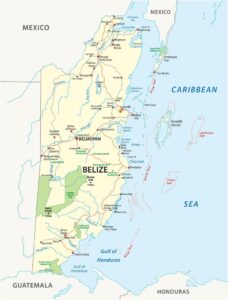Over the centuries, the territorial boundaries of Belize have been influenced by a rich yet contentious historical narrative. You may wonder why the border between Belize and Guatemala appears dotted on various maps, serving as a visual symbol of a long-standing territorial dispute. This enduring conflict stems from historical claims made by Guatemala, which has persistently challenged Belize’s right to sovereignty since its independence. The potential for international tension is substantial, as both nations are actively involved in diplomatic discussions aimed at resolving this complex boundary issue. Your investigation into this geopolitical enigma exposes the intricate challenges that surround national borders in Central America, where colonial legacies and concepts of territorial integrity persistently intersect, often in potentially volatile ways.
Diving Deep into the Historical Claims of the Belize-Guatemala Dispute
The ongoing territorial conflict between Belize and Guatemala can be traced back to a complex web of historical and colonial legacies. This dispute has its roots in the colonial era, when territorial boundaries were often ambiguously defined and subject to varying interpretations. The unresolved border issue has endured for centuries, leading to continuous tension between these neighbouring nations and impacting their diplomatic relations significantly. This historical backdrop is crucial for understanding the current dynamics between the two countries, as it illustrates how past events continue to shape contemporary geopolitics.

Unpacking Guatemala’s Long-standing Territorial Claims Over Belize
In essence, Guatemala has consistently upheld a historical claim of territorial rights over Belize, which is deeply rooted in the Spanish colonial administrative boundaries. You might be surprised to learn that Guatemala regards Belize as part of its original territorial inheritance from the Spanish Empire, which calls into question the modern borders that were established during British colonial rule. This historical viewpoint continues to energise Guatemala’s claims and complicate the ongoing sovereignty issue, showcasing the intricate layers involved in national identity and territorial rights.
Assessing the Broader Implications of Historical Borders
Since the colonial period, these disputed boundaries have generated significant geopolitical challenges for both nations. It is evident that undefined border regions create opportunities for conflict and diplomatic strains, affecting local communities and notions of national sovereignty. A thorough understanding of the border dispute reveals complex layers of historical, legal, and territorial dynamics. The implications extend beyond geographical demarcations, intertwining with economic, cultural, and security risks. The persistent conflict has significant ramifications for regional stability, international law, and the potential for future negotiations between Belize and Guatemala, underscoring the importance of resolving these historical grievances.
Deciphering the Significance of the Dotted Line on Maps
On many maps, you may observe a curious feature: a dotted boundary line separating Belize and Guatemala, which indicates an unresolved territorial dispute that has endured for decades. This distinctive cartographic representation highlights a complex geopolitical challenge, wherein the precise border remains undefined and hotly contested. The dotted line serves as a symbol of the ongoing diplomatic tension and the unresolved territorial claims that have marked the relationship between these two Central American nations for many years, revealing the intricate interplay of local and international politics.
International Recognition Amidst the Unresolved Border Dispute
Within the realm of international relations, Belize is recognised as a sovereign state with a notable international presence; however, the disputed border with Guatemala presents a nuanced geopolitical scenario. You might find it intriguing that despite Belize achieving independence in 1981, Guatemala has historically contested its territorial integrity. The dotted line not only signifies geographical uncertainty but also represents an ongoing diplomatic negotiation that continuously shapes regional relations and influences perceptions on both sides of the border.
The Diplomatic Weight of the Dotted Line
Beyond its depiction on maps, the dotted line functions as a potent diplomatic symbol. You can view it as a visual representation of unresolved territorial claims, signalling to the international community the intricate negotiations taking place between Belize and Guatemala. This unique border marking communicates the ongoing dialogue and the potential for a peaceful resolution of the conflict. However, the dotted line represents more than just a cartographic curiosity; it embodies a delicate diplomatic instrument that aims to avert military escalation while preserving an open channel for negotiation.
This line acts as a strategic buffer, enabling both nations to maintain diplomatic relations and strive for a possible future resolution. Its existence exemplifies how international borders can be managed through peaceful means, illustrating a sophisticated approach to territorial disputes that prioritises dialogue and mutual understanding over confrontation.

Key Conflicts and Diplomatic Agreements Shaping Belize and Guatemala Relations
The territorial disputes between Belize and Guatemala are deeply entrenched in history, characterised by complex diplomatic tensions and unresolved boundary claims. You’ll discover that the ongoing disagreement centres around competing interpretations of colonial-era treaties and the fundamental concept of territorial sovereignty. This dispute carries far-reaching implications for both nations, encompassing potential land ownership challenges and regional geopolitical dynamics that continue to define their relationship.
The Impact of the 1859 Treaty and Subsequent Developments
Before the signing of the 1859 treaty between Britain and Guatemala, territorial boundaries in the region were ambiguous and fiercely contested. It’s essential to recognise that this agreement aimed to delineate clear borders; however, subsequent interpretations led to ongoing disputes. Guatemala has consistently questioned the validity of the treaty, claiming that Britain failed to meet certain obligations regarding infrastructure development, which has become a central issue in their territorial disagreement.
International Court of Justice Involvement and Recent Diplomatic Efforts
Recent diplomatic efforts have focused on resolving the longstanding border dispute through international legal frameworks. You’ll note that both nations have opted to submit their case to the International Court of Justice (ICJ) for a binding resolution. This strategy marks a significant step towards peaceful conflict resolution and the potential normalisation of bilateral relations.
In addition to the ICJ proceedings, it is important to acknowledge the intricate diplomatic negotiations that have unfolded. The potential referendum in both countries to endorse the ICJ’s decision represents a distinctive method for resolving territorial disputes. Your awareness of this process highlights the delicate diplomatic efforts aimed at maintaining regional stability and resolving historical territorial claims through peaceful, internationally recognised avenues.
Gaining Insight into the Current Situation and Travel Considerations
Many travellers find themselves captivated by Belize’s unique border configuration with Guatemala. The ongoing territorial dispute has created a complex geopolitical environment that impacts travel and border crossings. Despite the prevailing tensions, tourists continue to explore both countries, navigating the delicate diplomatic landscape while considering international boundaries and local regulations.
Vital Tips for Safely Navigating the Border
When planning international travel to Belize, it is crucial to prepare meticulously and adhere to these important guidelines:
- Ensure you possess a valid passport and any necessary travel documentation
- Check the current status of diplomatic relations before embarking on your journey
- Secure appropriate travel insurance for your trip
- Stay informed regarding border crossing protocols to avoid complications
The most critical aspect is to remain vigilant of your surroundings and respect local regulations to guarantee a seamless travel experience.
Community Perspectives and Local Sentiments Regarding the Dispute
Beneath the surface of the border dispute lie deep-rooted historical tensions and intricate cultural dynamics. Communities located near the border experience the direct repercussions of the dispute, with generational memories of conflict significantly influencing their outlooks. Residents often find themselves balancing national pride with a desire for peaceful coexistence, highlighting the human dimension of this geopolitical issue.
Delving Deeper into Community Dynamics
To genuinely grasp the local perspective, you should explore the nuanced landscape of cultural identity. You’ll discover that border communities have developed unique survival strategies, blending resilience with diplomatic pragmatism. Indigenous groups, in particular, play a pivotal role in fostering cross-border relationships, often transcending official diplomatic tensions through grassroots connections and shared cultural experiences, thereby nurturing a sense of unity amidst the conflict.

Anticipating Future Implications of the Belize-Guatemala Border Dispute
Despite the ongoing territorial dispute, there exists a possibility for significant geopolitical transformations. The unresolved border issue between Belize and Guatemala continues to foster tension, with implications that could reshape diplomatic relations in Central America. You may observe that resolving this dispute could profoundly impact regional stability, economic cooperation, and the international perceptions of both nations, potentially leading to a more harmonious coexistence.
Enduring Dialogue Between Belize and Guatemala
Dialogue serves as the primary mechanism for addressing the territorial disagreement. You will find that both countries have engaged in diplomatic negotiations, striving for peaceful resolutions through international platforms such as the Organization of American States (OAS). These discussions reflect a commitment to avoiding military confrontation and finding a mutually acceptable solution to their protracted border dispute, underscoring the significance of dialogue in conflict resolution.
Exploring Viable Pathways Towards a Resolution
Above all, you should recognise that multiple strategies exist for resolving the border conflict. International mediation and bilateral negotiations offer potential routes for progress. You might encounter approaches such as joint territorial management, referendums, or interventions from international courts as viable methods to effectively address the dispute.
The implications of resolving the conflict extend far beyond mere border demarcation. You will discover that successful negotiations could unlock significant economic opportunities for both Belize and Guatemala. Potential benefits could encompass enhanced trade, improved cross-border cooperation, and increased foreign investment. The most transformative outcome would be the establishment of permanent territorial sovereignty, which could significantly reduce regional tensions and promote long-term stability in Central America.
Understanding the Regional Dynamics of the Belize-Guatemala Conflict
Unlike many other border disputes in Central America, the Belize-Guatemala territorial conflict is steeped in deep historical complexities that have profoundly shaped regional geopolitical interactions. You’ll find that this longstanding disagreement reflects broader patterns of territorial tension, involving colonial legacies, post-independence territorial claims, and intricate diplomatic negotiations that have intricately influenced the political landscape of the region.
The Impact of the Dispute on Central American Relations
After decades of territorial disputes, you can observe how this conflict has strained diplomatic relationships between Belize and Guatemala. The ongoing tension has periodically disrupted regional cooperation, creating hurdles for economic integration and mutual understanding within the broader Central American community, making it increasingly vital to resolve these issues for regional prosperity.
The Role of International Organizations in Mediation Efforts
With diplomatic mediation playing a critical role, international organisations have actively participated in efforts to resolve the border dispute. You’ll notice that entities like the Organization of American States (OAS) have been instrumental in facilitating dialogue and proposing feasible resolution strategies.
A comprehensive network of international organisations has been strategically involved in addressing the Belize-Guatemala border dispute. The United Nations, OAS, and various diplomatic channels have worked tirelessly to prevent escalation, providing mediation services and promoting peaceful negotiation. You’ll appreciate how these organisations have played a crucial role in maintaining stability, offering a structured approach to resolving territorial disagreements and mitigating potential military confrontations.
Reflecting on the Complexities of the Belize-Guatemala Border Dispute
As you weave together the intricate threads of Belize’s territorial history, you can perceive how the nation’s border with Guatemala stands as a testament to unresolved colonial legacies. Your exploration of this geopolitical puzzle reveals that the dotted border signifies more than a mere cartographic curiosity; it embodies ongoing diplomatic negotiations and historical tensions. Your understanding of this dispute unveils the intricate challenges facing post-colonial states, where territorial boundaries continue to ignite international dialogue. The unresolved status underscores the delicate balance between historical claims and contemporary diplomatic resolutions, inviting you to appreciate the nuanced complexity inherent in international border disputes.

Frequently Asked Questions: Insights into the Belize-Guatemala Border Dispute
What is the reason behind the dotted border between Belize and Guatemala?
The dotted border represents a long-standing territorial dispute between Belize and Guatemala, originating from conflicts that date back to the colonial era. Spain initially asserted claims over the territory, and following Belize's independence from Britain in 1981, Guatemala continued to uphold its territorial assertions, culminating in an undefined border demarcation depicted by the characteristic dotted line on maps.
Has the border dispute between Belize and Guatemala reached a resolution?
The dispute remains partially unresolved; however, significant progress has been achieved. In 2019, both countries consented to submit the territorial disagreement to the International Court of Justice (ICJ) for a binding resolution. A referendum in both nations supported this strategy, indicating a diplomatic pathway towards conclusively settling the border controversy.
What are the historical origins of the border conflict between Belize and Guatemala?
The conflict has its origins in the 1859 treaty between Britain and Guatemala, which promised infrastructure development in exchange for territorial recognition. When Britain failed to fully meet these obligations, Guatemala began to challenge Belize’s territorial integrity. This historical misunderstanding has perpetuated decades of tension, with Guatemala maintaining claims over approximately 53% of Belize’s current national territory.
The Article Why Is Belize’s Border Dotted? Exploring the Guatemala Dispute appeared first on Belize Travel Guide
The Article Belize’s Border Dotted: Unraveling the Guatemala Dispute Was Found On https://limitsofstrategy.com

